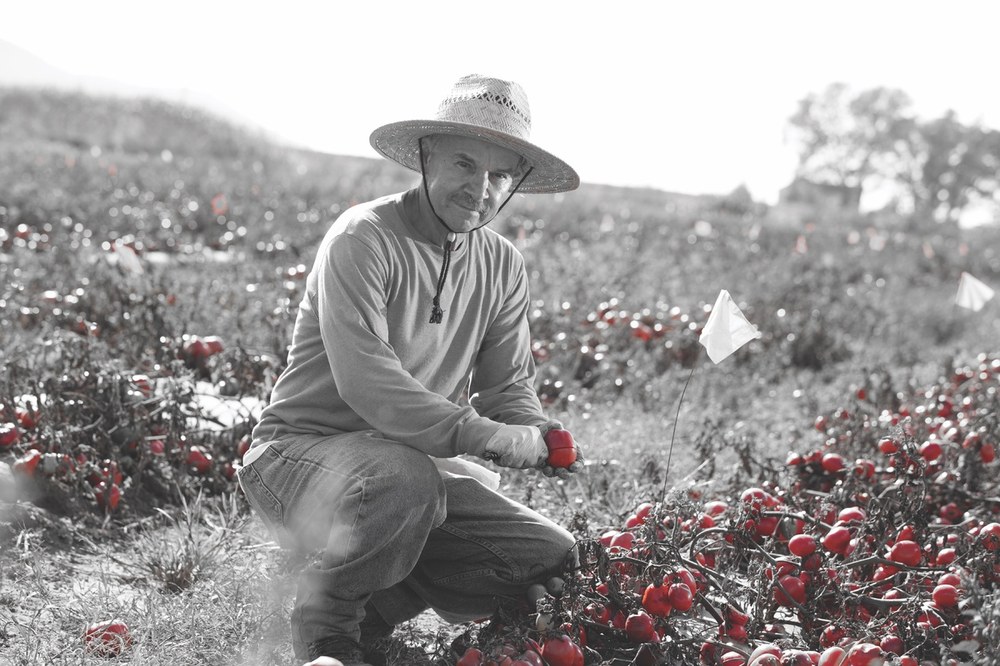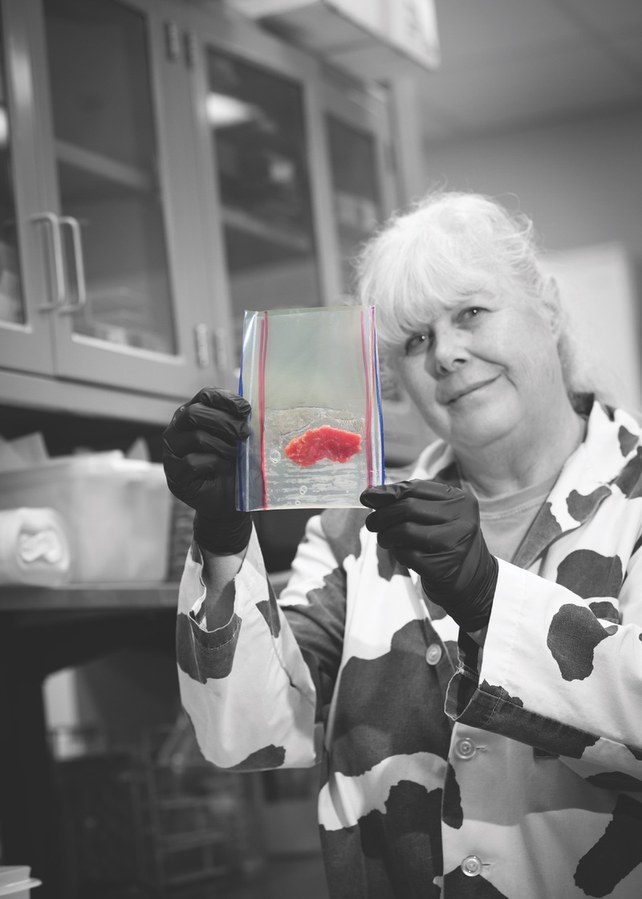Posted: November 30, 2023
From Research Discoveries to Marketplace Solutions

Majid Foolad, professor of plant genetics, has conducted years of careful breeding between wild-type tomatoes and hybrids. He developed a variety of grape tomato that is optimal for growing in Pennsylvania and beyond. Photo: Michael Houtz
Every day, researchers throughout Penn State's College of Agricultural Sciences are making exciting discoveries, unearthing knowledge that has the potential to solve real-world problems.
However, the true impact of these discoveries lies not only in their academic significance but also in their translation into the marketplace, bridging the gap between theory and application for the betterment of society.
The journey toward commercialization for researchers can be difficult, especially as they are sometimes treading unfamiliar ground as scientists entering the corporate world, noted Blair Siegfried, associate dean for research and graduate education in the college.
"The gap between academic research and commercialization can be challenging," he said. "Our scientists are incredibly fortunate that the college has invested in a program that empowers them to transform their research discoveries into tangible commercial solutions."
Since 2013, the Office for Research and Graduate Education and the Entrepreneurship and Innovation Program have tried to bridge this gap with funding through the Research Applications for INnovation program (RAIN), awarding nearly $1.7 million to 31 projects showing commercial promise.
The program is shepherded by Maria Spencer, the John and Patty Warehime Entrepreneur in Residence, and Scott Welsh, serving as a licensing and commercialization consultant to the College of Agricultural Sciences as the managing partner of Fieldstone Innovations.
"Their unwavering commitment and expertise in bridging the gap between the lab and marketplace is invaluable, propelling our institution toward real-world impact and fostering innovation that positively shapes our society to support food safety, resiliency and farmers," Siegfried said.
Pathogen-killing packaging
According to the U.S. Centers for Disease Control and Prevention, foodborne illness cases total 48 million yearly in the United States alone, resulting in 128,000 hospitalizations and 3,000 deaths.
What if there were a way to package foods such as meat, poultry and fish that could make the foods safer — and decrease foodborne illness — by destroying pathogens as well as extending shelf life? That's what Catherine Cutter, professor of food science, and her research group set out to discover. Cutter's team has developed a composite film, created by bonding an antimicrobial layer to the clear polyethylene plastic typically used to vacuum-package foods such as meat, poultry and fish.
The antimicrobial lining of the film is made with pullulan, a water-soluble polymer made up of sugar, glycerin and cellulose molecules. To kill pathogens such as Salmonella, Listeria and E. coli, the researchers infuse the pullulan with Lauric arginate, an antimicrobial food preservative made from naturally occurring substances. The pullulan layer allows for a gradual release of the antimicrobial, providing continuous bacteria-killing activity on the meat's surface. Pullulan is used commercially in the U.S. for a few products, including quick-dissolving mouthwash strips.

Food scientist Catherine Cutter led a team that developed a novel composite film — created by bonding an antimicrobial layer to conventional, clear polyethylene plastic typically used to vacuum-package foods such as meat and fish — that could help decrease foodborne illness outbreaks.
"These strips are a great way to demonstrate how pullulan behaves," said Cutter, who recently received the prestigious Fellow Award from the International Association for Food Protection in recognition of her contributions to food safety. "If you put a strip on your tongue, it dissolves immediately — that's what the pullulan does on the meat's surface, releasing the Lauric arginate."
Since developing and securing a patent for the antimicrobial film, Cutter's research group has been tweaking the formulation in response to questions from potential industry adopters.
"The patent guidelines allow for modification, and we're finding some things we can do that improve the feasibility of the film in a commercial setting, but that are still within the guidelines," Cutter said.
For example, graduate student Brittani Bedford is adjusting the parameters of the formulation in a pilot plant scenario at the Penn State Behrend Plastics Innovation Center. One discovery she made is that xanthan gum, an element in the original film formulation, inhibits the activity of Lauric arginate and slows down the drying of the formulation on the plastic wrap.
"We realized we don't need the xanthan gum, so we eliminated it," Cutter said.
Cutter's research group continues to examine components of their formulation in the context of how it will work in commercial settings.
"We want the formula to dry fast, dispense well and perform well at different temperatures — all factors that will come into play in real-world conditions," she said.
An award-winning tomato
There's nothing like a flavorful, juicy, bright red tomato fresh-picked from the garden. In Pennsylvania, though, a short growing season, coupled with pest and disease challenges, can make that ideal homegrown tomato hard to come by.
Majid Foolad, professor of plant genetics, tackled those challenges and, after conducting years of careful breeding between wild-type tomatoes and hybrids, developed a variety of grape tomato that's optimal for the region and beyond. Through a partnership with 50-year-old supply company Johnny's Selected Seeds, that tomato variety — under the commercial name Valentine — is thriving in the market.
When Foolad initiated his tomato breeding program at Penn State, he and his research team focused on several traits: cold tolerance, disease resistance, and food quality and nutrition.
"Everyone has had the experience of buying disappointing tomatoes in the supermarket — the kind that can be pale and flavorless," he said. "That can happen if breeders prioritize shelf life over taste."
Another desirable characteristic Foolad prioritized was high lycopene content. Lycopene, a powerful antioxidant that gives tomatoes their rich red color, may also help protect against heart disease and certain cancers. Using tomato species grown in South America, Foolad and his graduate students screened 300 genetic lines, also called accessions, for lycopene content.
"We had to map the genome and classify the genes that contribute to high lycopene content, then transfer those genes to tomato varieties," he said. "Varieties need to be tested again and again to be sure they perform well in various seasons, conditions and environments. It took many years, many graduate students and support from the college. The two RAIN grants we received helped us mass produce seed, which is critical when testing a variety."
The researchers' patience and hard work paid off when they found that one particular wild accession had four to five times more lycopene than domesticated cultivars of tomatoes. Because that accession also showed some disease-resistance traits, they narrowed their focus to that accession, which was ultimately patented for its high lycopene content.
That accession was crossed with one of Johnny's lines and became Valentine — the most desirable hybrid for commercialization.
"We're very proud of Valentine for its high lycopene content, superior disease resistance and exceptionally high yields," Foolad said. "Ultimately, we want to develop quality tomatoes that look and taste good. Quality has always been the hallmark of my program."
That quality was recognized when Valentine was named an All-America Selections winner for 2018 by a panel of professional, independent judges throughout North America.
Today, Valentine is available nationwide — and even though the variety is optimized for Pennsylvania conditions, it performs well in many regions.
"I've been getting great feedback, receiving messages from growers in Hawaii, in Florida," Foolad said. "Johnny's tells me it continues to be a very popular grape tomato variety."
Protecting soil and water
Cover crops are important in agricultural fields because they help reduce soil erosion and agricultural chemical runoff into waterways. But cover crops can be difficult to grow because they compete with cash crops if they are seeded at the same time. For example, establishing a cover crop for corn after the plants are a few inches high is almost impossible without damaging the corn.
With support from one of the earliest RAIN grants, a team of researchers and graduate students in the college examined this problem and developed the InterSeeder. This specialized grain drill lets growers plant cover crops between rows of corn after the corn is established.
Today, InterSeeder Technologies has been selling the product for more than five years. InterSeeders are in use in almost 20 states as well as Ontario, Canada.
"It all started as a research project with graduate students at the time, Chris Houser and Corey Dillon," said Greg Roth, professor emeritus of agronomy and scientific adviser for InterSeeder Technologies. "They built a prototype, and they came to me and said, 'We should patent this.'"
Along with Bill Curran, professor emeritus of weed science, Roth and the graduate students secured patents for the InterSeeder and began the process of starting their own company.
Houser and Dillon took an entrepreneurship class through Ben Franklin Technology Partners and entered a competition with their InterSeeder prototype. After winning the grand prize of $7,500, they began advertising their product, and sales followed.

Greg Roth, professor emeritus of agronomy, was one of a team of researchers and graduate students who developed the InterSeeder. This specialized grain drill lets growers plant cover crops between rows of corn after the corn is established.
Roth's 30-year career in extension was a natural fit for receiving feedback from users.
"Working in extension, I always appreciated that growers provide you with instant feedback," he said. "And the same thing happens with growers and researchers who purchase InterSeeders. For example, a user in Vermont told us the machine was sinking into the soil. Chris and I went up and got it, made modifications and delivered it back. That's part of what we do — we can customize the machines based on feedback from customers."
For Roth, gaining experience in business development has been a surprising but welcome development in his career.
"We all learned a lot about marketing, entrepreneurship and other aspects that go into starting a business," he said. "The college provided invaluable support to help us get our project off the ground, and the RAIN grants helped us develop it even further."
Spencer said she is proud of the resounding successes achieved through the program, propelling the program and recipients to new heights of creativity and advancement.
"We are fortunate to have both funding and expert staff in place to support researchers and students along this path," Spencer said. "Funding for this early stage of commercialization is rare and valuable, and the entrepreneurship and innovation team works hard to support researchers in making the most of it. The college has so much potential for research impact, and I'm grateful to be a small part of the bridge that helps bring these technologies to those who can benefit from them."
By Krista Weidner
Photography by Michael Houtz
Features
Breaking the Silence on Farm Stress
Farming has always been a demanding profession, but today's farmers face unprecedented pressures that can severely impact their mental health.
Biting Back
Research Targets Vector-Borne Diseases to Save Lives
Leading Forward
Ott brings deep connection to role of dean.


